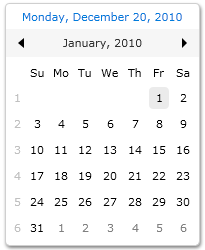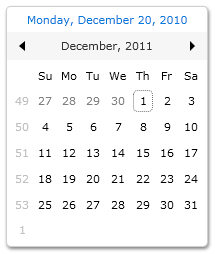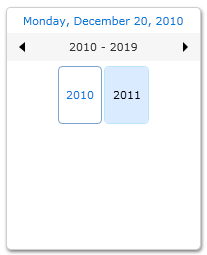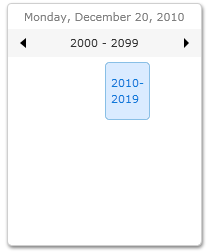
Intersoft ClientUI Documentation
DisplayDateStart Property

| Intersoft.Client.UI.Aqua.UXInput Namespace > UXCalendar Class : DisplayDateStart Property |
<CategoryAttribute("Common Properties")> <TypeConverterAttribute("Intersoft.Client.Framework.DateTimeTypeConverter, Intersoft.Client.Framework, Version=3.0.5000.1, Culture=neutral, PublicKeyToken=c3d9b11444163e76")> Public Property DisplayDateStart As Nullable(Of Date)
Dim instance As UXCalendar Dim value As Nullable(Of Date) instance.DisplayDateStart = value value = instance.DisplayDateStart
[CategoryAttribute("Common Properties")] [TypeConverterAttribute("Intersoft.Client.Framework.DateTimeTypeConverter, Intersoft.Client.Framework, Version=3.0.5000.1, Culture=neutral, PublicKeyToken=c3d9b11444163e76")] public Nullable<DateTime> DisplayDateStart {get; set;}
[CategoryAttribute("Common Properties")] [TypeConverterAttribute("Intersoft.Client.Framework.DateTimeTypeConverter, Intersoft.Client.Framework, Version=3.0.5000.1, Culture=neutral, PublicKeyToken=c3d9b11444163e76")] public: property Nullable<DateTime> DisplayDateStart { Nullable<DateTime> get(); void set ( Nullable<DateTime> value); }
The range of dates displayed is governed by the DisplayDateStart and DisplayDateEnd properties. If DisplayMode is Year or Decade, only months or years that contain displayable dates will be displayed.
The following example shows UXCalendar with display range starts from January 2010 to December 2011.
| XAML |
Copy Code
|
|---|---|
<Intersoft:UXCalendar x:Name="UXCalendar1" DisplayDate="1/1/2010" DisplayDateStart="1/1/2010" DisplayDateEnd="12/31/2011"/> |
|




Target Platforms: Windows 7, Windows Vista SP1 or later, Windows XP SP3, Windows Server 2008 (Server Core not supported), Windows Server 2008 R2 (Server Core supported with SP1 or later), Windows Server 2003 SP2